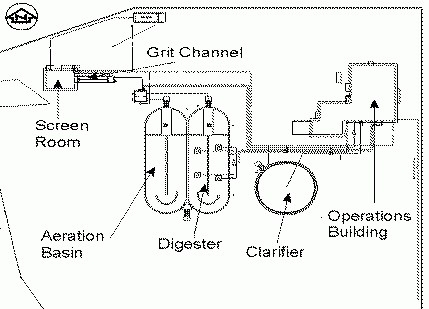9575 Bare Point Road, Chemainus, BC
Chemainus Sewer Area Map (PDF)

Wastewater is pumped to the Inlet Works Facility where large particles are removed by a mechanical screen. In addition, grit is removed in settling channels.
The wastewater is then piped to an aerated tank where it is mixed with microorganisms. The microorganisms consume the organics producing more microorganisms.
The treated wastewater along with the microorganisms are then piped to two secondary settling tanks. The microorganisms settle to the bottom of the tanks. The treated wastewater, less the microorganisms flow over the secondary settling tanks’ weirs to the outfall in the Stuart Channel.
Some of the microorganisms that settled to the bottom of the secondary settling tanks are pumped back into the aerated tank while excess microorganisms are pumped to an aerated digestion tank.
The microorganisms are treated further in the aerated digestion tank before being pumped to a dewatering press. The dewatering press reduces the volume by 6 fold. The resulting material is called biosolids and has the consistency of peanut butter.
The Chemainus Waste Water Treatment Plant removes approximately 95% of the organic matter and solids in the wastewater. This far exceeds the Ministry of Land, Water, and Air Protection’s requirements. The effluent is of a very high quality.
- Cost: $2.9 million dollars - 1 million for off-site works
- Population Served in 1998: 3,100
- Design Population in 2018: 4,600
- Design Flow Capacity: 2,140 cubic metres per day
- Treatment Process: Extended Aeration Activated Sludge, Aerobic Digestion, Belt Filter Press Dewatering
- Funded: 1/3 Municipal, 1/3 Provincial, 1/3 Federal
- Consultants: Delcan (Civil / Environmental) and Shaflik Engineering (Electrical)
- Contractor: Maple Reinders Inc.
- Commissioned: November 1998
